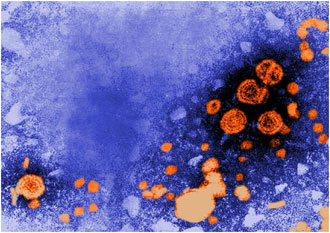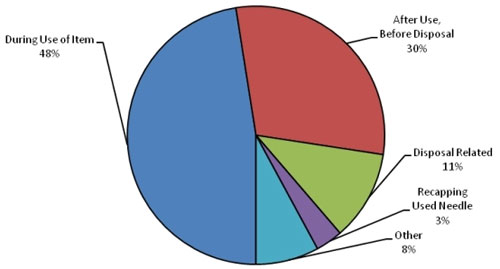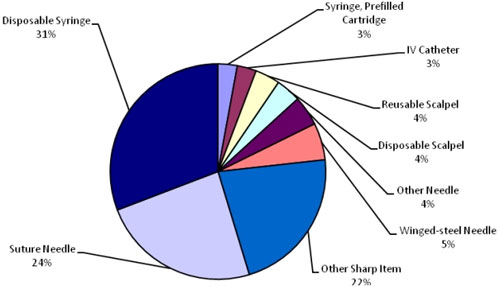 |
 This transmission electron
micrograph (TEM) revealed the presence of hepatitis B virions.
The large round virions are known as Dane particles.
Photo courtesy of CDC/ Dr. Erskine Palmer.
This transmission electron
micrograph (TEM) revealed the presence of hepatitis B virions.
The large round virions are known as Dane particles.
Photo courtesy of CDC/ Dr. Erskine Palmer. High Risk Exposures
The healthcare setting can be a risky place
to work. During the provision of routine healthcare, there
exist high risk practices and procedures that are capable
of causing healthcare acquired infection with blood borne
pathogens.
The CDC estimates that about 385,000 sharps-related injuries occur annually among healthcare workers in hospitals. More recent data from the Exposure Prevention Information Network (EPINet) suggest these injuries can be reduced, as sharps-related injuries in nonsurgical hospital settings decreased 31.6% during 2001–2006 (following the Needlestick Safety and Prevention Act of 2000). However, injuries in surgical settings increased 6.5% in the same period, where adoption of safety devices was limited compared to nonsurgical settings. It has been estimated about half or more of sharps injuries go unreported. Most reported sharps injuries involve nursing staff, but laboratory staff, physicians, housekeepers, and other health care workers are also injured (CDC, 2013).
A sharps injury is a penetrating stab wound from a needle, scalpel, or other sharp object that may result in exposure to blood or other body fluids. Sharps injuries are typically the result of using dangerous equipment in a fast-paced, stressful, and understaffed environment. These strenuous demands often produce feelings of fatigue, frustration, and occasionally anger. In the operating room, for example, health care personnel do not have the luxury of "taking a break," but must continue with their duties until the procedure is completed. These conditions can increase the risk of injury and infection for health care workers (CDC, 2013).
Health care workers may also incur injuries from improper procedures, such as passing sharps hand-to-hand between team members, placing sharps in a disposal container, or failing to use a safer sharps device. A report from the Exposure Prevention Information Network (EPINet) found that nearly half of all sharps injuries occurred during use of the sharp, and of the nearly 40% of needle injuries which involved a safety designed needle, the majority occurred before activating the safety device. Moreover, the report also showed that many sharps injuries occurred in patient rooms among nurses and operating rooms among surgical team members (CDC, 2013).
The New York State syllabus for the Mandatory Infection Control training identifies high risk practices and procedures capable of causing healthcare acquired infection with bloodborne pathogens:
- Percutaneous exposures
- Other sharps injuries
- Mucous membranes and non-intact skin exposures
- Parenteral exposure.
Percutaneous exposures occur through handling/disassembly/disposal/reprocessing of contaminated needles and other sharp objects. This can occur through manipulating contaminated needles and other sharp objects by hand (e.g., removing scalpel blades from holders, removing needles from syringes, or recapping contaminated needles and other sharp objects using a two-handed technique), or by delaying or improperly disposing (e.g., leaving contaminated needles or sharp objects on counters/workspaces or disposing in non-puncture-resistant receptacles).
After percutaneous injury with a contaminated sharp instrument, the average risk of HIV infection is 0.3% (CDC, 2011b).
Estimates of Hepatitis B infections (HBV) have decreased significantly since 1985. The CDC estimated that 12,000 HBV infections occurred in healthcare personnel in 1985. By 1997, the number declined to approximately 500 cases. This decline, of more than 95% is due largely to the widespread immunization of healthcare personnel. Although universal precautions also help reduce blood exposures and HBV infections in healthcare personnel (CDC, 2008).
Occupational exposure resulting in Hepatitis C infections (HCV) are more difficult to estimate among healthcare personnel. Retrospective studies show that the average risk of HCV transmission after percutaneous exposure to an HCV-positive source is 1.8% (CDC, 2008).
In addition to the use of sharps devices, injuries are also closely associated with certain work practices that can pose an increased risk of bloodborne pathogen exposure. These work practices include:
- Disposal-related activities (11%)
- Activities after use and prior to disposal, such as item disassembly (30%)
- Recapping a used needle (3%)

Figure 1: Activities associated with percutaneous injuries in EPINet hospitals, by % total percutaneous injuries (n= 951), 2007 (Source: EPINet [2009] ). ).
Injuries are also closely associated with certain devices that can pose an increased risk of bloodborne pathogen exposure. These devices include:
- Disposable Syringe (31%)
- Suture Needle (24%)
- Winged Steel Needle (5%)

Figure 2: Devices associated with percutaneous injuries in EPINet hospitals, by % total percutaneous injuries (n= 951), 2007 (Source: EPINet [2009] ). The EPINet report surveyed 29 health care facilities across the United States, 2007. ). The EPINet report surveyed 29 health care facilities across the United States, 2007.
Other means of sharps injury can occur when performing
procedures where there is poor visualization, such as: Blind
suturing, non-dominant hand opposing or next to a sharp, or
performing procedures where bone spicules or metal fragments
are produced.
Mucous membranes and non-intact skin exposures are
also a potential method for exposure to bloodborne pathogens.
Direct blood or body fluid contact with the eyes, nose, mouth
or other mucous membranes occurs through contact with contaminated
hands, contact with open skin lesions/dermatitis, or splashes/sprays
of blood or body fluids such as might occur during irrigation
or suctioning.
Parenteral exposures may occur through injection with
infectious material while administering parenteral medications,
sharing of blood monitoring devices such as glucometers, hemoglobinometers,
lancets, lancet platforms/pens, or through the infusion of
contaminated blood products or fluids.
Additional practice to prevent percutaneous exposures include:
- Avoid unnecessary use of needles and other sharp objects.
- Use care in the handling and disposing of needles and
other sharp objects.
- Avoid recapping unless absolutely medically necessary.
- When recapping, use only a one-hand technique or safety
device.
- Pass sharp instruments by use of designated "safe zones".
- A "safe zone" is an area such as a tray or basin
on the sterile field where an instrument is placed before
being picked up by a second person. This can prevent
"collision" injuries where OR personnel can be tuck
by another when passing instruments.
- Disassemble sharp equipment by use of forceps or other
devices.
- Modify procedures to avoid injury:
- Use forceps, suture holders or other instruments
for suturing.
- Avoid holding tissue with fingers when suturing or
cutting.
- Avoid leaving exposed sharps of any kind on patient
procedure/treatment work surfaces.
- Appropriately use safety devices whenever available:
- Always activate safety features. o Never circumvent
safety features.
Safe Injection Practices and Procedures
Injection safety, or safe injection practices, is a set of measures taken to perform injections in an optimally safe manner for patients, healthcare personnel, and others.
The Standard Precautions section of the 2007 Guideline for Isolation Precautions provides evidence-based recommendations for safe injection practices and reflects the minimum standards that healthcare personnel should follow to prevent transmission of infections in healthcare settings.
Despite these recommendations, outbreaks and patient notifications resulting from healthcare personnel failing to adhere to Standard Precautions and basic infection control practices continue to be reported. Unsafe injection practices that have resulted in disease transmission have most commonly included:
- Using the same syringe to administer medication to more than one patient, even if the needle was changed or the injection was administered through an intervening length of intravenous (IV) tubing ;
- Accessing a medication vial or bag with a syringe that has already been used to administer medication to a patient, then reusing contents from that vial or bag for another patient ;
- Using medications packaged as single-dose or single-use for more than one patient ;
- Failing to use aseptic technique when preparing and administering injections].
For these reasons, CDC reminds healthcare personnel of the following practices that are critical for patient safety:
- Never administer medications from the same syringe to more than one patient, even if the needle is changed or you are injecting through an intervening length of IV tubing.
- Do not enter a medication vial, bag, or bottle with a used syringe or needle.
- Never use medications packaged as single-dose or single-use for more than one patient. This includes ampoules, bags, and bottles of intravenous solutions.
- Always use aseptic technique when preparing and administering injections.
Injection safety or safe injection practices are a set of measures taken to perform injections in an optimally safe manner for patients, healthcare personnel, and others. A safe injection does not harm the recipient, does not expose the provider to any avoidable risks and does not result in waste that is dangerous for the community. Injection safety includes practices intended to prevent transmission of bloodborne pathogens between one patient and another, or between a healthcare worker and a patient, and also to prevent harms such as needlestick injuries. Safe injection practices are not optional.They are a basic expectation anywhere injections are administered. It may be hard to believe, but over the last decade, syringe reuse and misuse of medication vials have resulted in dozens of outbreaks and the need to alert over 100,000 patients to seek testing for bloodborne pathogens such as Hepatitis B virus, Hepatitis C virus, and HIV.
Providers should maintain aseptic technique throughout
all aspects of injection preparation and administration, which
includes the following:
- Medications should be drawn up in a designated "clean"
medication area that is not adjacent to areas where potentially
contaminated items are placed.
- Use a new sterile syringe and needle to draw up medications
while preventing contact between the injection materials
and the non-sterile environment.
- Ensure proper hand hygiene before handling medications.
- If a medication vial has already been opened, the rubber
septum should be disinfected with alcohol prior to piercing
it.
- Never leave a needle or other device (e.g. "spikes")
inserted into a medication vial septum or IV bag/bottle
for multiple uses. This provides a direct route for microorganisms
to enter the vial and contaminate the fluid.
- Medication vials should be discarded upon expiration or
any time there are concerns regarding the sterility of the
medication.
- Never administer medications from the same syringe to
more than one patient, even if the needle is changed.
- Never use the same syringe or needle to administer IV
medications to more than one patient, even if the medication
is administered into the IV tubing, regardless of the distance
from the IV insertion site.
- All of the infusion components from the infusate to
the patient's catheter are a single interconnected unit.
- All of the components are directly or indirectly
exposed to the patient's blood and cannot be used for
another patient.
- Syringes and needles that intersect through any port
in the IV system also become contaminated and cannot
be used for another patient or used to re-enter a non-patient
specific multi-dose vial.
- Separation from the patient's IV by distance, gravity
and/or positive infusion pressure does not ensure that
small amounts of blood are not present in these items.
- Never enter a vial with a syringe or needle that has
been used for a patient if the same medication vial might
be used for another patient.
- Dedicate vials of medication to a single patient.
- Medications packaged as single-use must never be used
for more than one patient:
- Never combine leftover contents for later use;
- Medications packaged as multi-use should be assigned
to a single patient whenever possible;
- Never use bags or bottles of intravenous solution
as a common source of supply for more than one patient.
- Never use peripheral capillary blood monitoring devices
packaged as single-patient use on more than one patient:
- Restrict use of peripheral capillary blood sampling devices
to individual patients.
- Never reuse lancets. Consider selecting single-use lancets
that permanently retract upon puncture.
Safe injection practices as identified in the CDC's
Guideline for Isolation Precautions: Preventing Transmission
of Infectious Agents in Healthcare Settings 2007 include
the following recommendations apply to the use of needles,
cannulas that replace needles, and, where applicable intravenous
delivery systems (CDC, 2007):
- Use aseptic technique to avoid contamination of sterile
injection equipment.
- Do not administer medications from a syringe to multiple
patients, even if the needle or cannula on the syringe is
changed. Needles, cannulae and syringes are sterile, single-use
items; they should not be reused for another patient nor
to access a medication or solution that might be used for
a subsequent patient.
- Use fluid infusion and administration sets (i.e., intravenous
bags, tubing and connectors) for one patient only and dispose
appropriately after use. Consider a syringe or needle/cannula
contaminated once it has been used to enter or connect to
a patient's intravenous infusion bag or administration set.
- Use single-dose vials for parenteral medications whenever
possible.
- Do not administer medications from single-dose vials
or ampules to multiple patients or combine leftover contents
for later use.
- If multidose vials must be used, both the needle or cannula
and syringe used to access the multidose vial must be sterile.
- Do not keep multidose vials in the immediate patient
treatment area and store in accordance with the manufacturer's
recommendations; discard if sterility is compromised or
questionable.
- Do not use bags or bottles of intravenous solution as
a common source of supply for multiple patients.
Surveillance/Evaluation
As stated previously, there are an estimated 385,000 needlesticks and other sharps-related injuries sustained by hospital-based healthcare personnel annually; there are an average of 1,000 sharps injuries per day (CDC, 2007). Healthcare providers who may be exposed to blood or other potentially infected material are at risk, particularly if they are exposed to contaminated needles or other contaminated sharps that may cause injury.
Surveillance is defined as the ongoing, systematic collection,
analysis, interpretation, and dissemination of data regarding
a health-related event for use in public health action to
reduce morbidity and mortality and to improve health (CDC,
2007). Multiple agencies require ongoing evaluation of potential
hazards from bloodborne pathogens, including the Occupational
Safety and Health Administration (OSHA), the Centers for Disease
Control and Prevention (CDC), National Institute for Occupational
Safety and Health (NIOSH). In New York State, the Department
of Health and each individual healthcare organization or facility
has policies that support the safety of patients and healthcare
providers, as well as identifying how and to whom HAIs are
reported and analyzed.
The National Healthcare Safety Network (NHSN) is a secure, internet-based surveillance system that integrates and expands legacy patient and healthcare personnel safety surveillance systems managed by the Division of Healthcare Quality Promotion (DHQP) at CDC. NHSN also includes a new component for hospitals to monitor adverse reactions and incidents associated with receipt of blood and blood products. Enrollment is open to all types of healthcare facilities in the United States, including acute care hospitals, long term acute care hospitals, psychiatric hospitals, rehabilitation hospitals, outpatient dialysis centers, ambulatory surgery centers, and long term care facilities(2013). Annual reports are generated and can be accessed at http://www.cdc.gov/nhsn/dataStat.html.
While any sharp device can cause injury and has the potential
for disease transmission, some devices have a higher disease
transmission risk, such as hollow-bore needles. Other devices
have higher injury rates, such as butterfly-type IV catheters
and devices with recoil action, blood glucose monitoring devices
with lancet platforms/pens. It is important to identify the
settings in which exposures occur and the circumstances by
which exposure is more likely to occur.
Contiune to Element III,
Con't.
|
 |